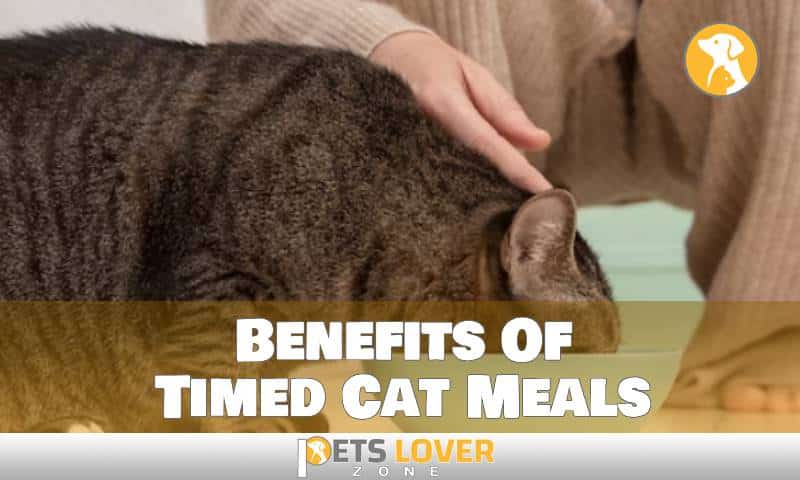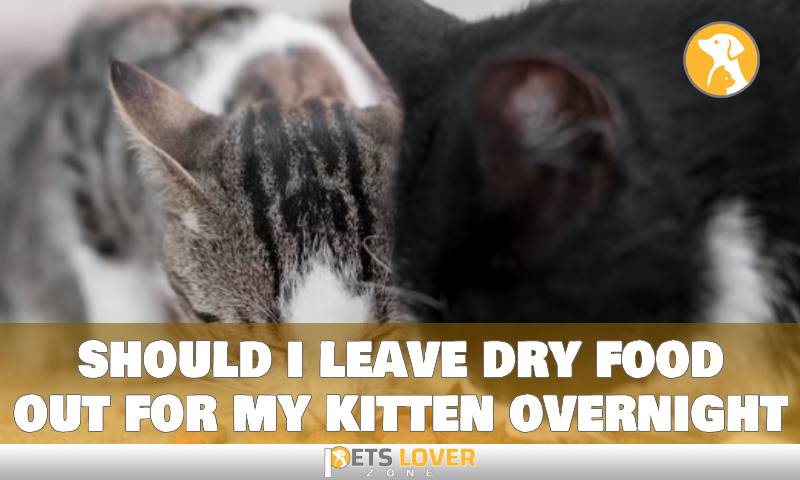To switch from free feeding to scheduled cat feeding, gradually introduce new feeding times over several days. Begin by offering meals at consistent times each day with appropriate portion sizes.
This will help prevent obesity and maintain a healthy weight for your feline friend. Cats are natural grazers, but free feeding can lead to overeating and unhealthy habits. By switching to a scheduled feeding routine, pet owners can ensure their cats are getting the right amount of food at the right time.
It’s important to remember that the transition to scheduled feeding should be gradual to minimize any stress or discomfort for your cat. In this article, we’ll discuss the benefits of scheduled feeding for cats, the steps for transitioning from free feeding to scheduled feeding, and tips for maintaining a healthy feeding routine.
Overview Of How To Switch From Free Feeding To Scheduled Feeding
Transitioning from free feeding to scheduled feeding is an essential yet challenging approach that requires commitment and patience from cat owners. In a free-feeding approach, cats have constant access to food throughout the day, while in a scheduled-feeding approach, their meals come at specific times of the day.
If you’re looking to switch to scheduled feeding, here are the key points to consider:
Understanding Your Cat’s Feeding Requirements And Behavior
Before making any changes to their feeding routine, it is crucial to understand your cat’s feeding requirements and behavior. Knowing their daily calorie requirements will help you select the right amount of food to feed them. Additionally, observing their feeding behavior and knowing their appetite patterns can help you create a feeding schedule that works best for them.
Here are other factors to consider when switching to scheduled feeding:
- Consider their age, breed, and weight
- Monitor their daily activity levels
- Know their appetite and feeding habits
- Determine their feeding times
How To Select The Right Type Of Food For Scheduled Feeding
Switching from free feeding to scheduled feeding doesn’t mean compromising your cat’s nutritional needs. It is essential to choose the right type of food that meets their dietary requirements and taste preferences. Here are the key factors to consider:
- Age- appropriate food
- Wet or dry foods
- Protein content
- Nutritional value
- Brand selection
Overall, switching from free feeding to scheduled feeding demands a gradual transition beyond merely changing your cat’s feeding schedule. With patience and consistency, you can successfully adapt your cat to the new feeding routine, ensuring they stay healthy and active.
Benefits Of Timed Cat Meals

Switching from free feeding to scheduled cat meals comes with a lot of benefits that help maintain your cat’s overall health. Free feeding, where food is constantly available, can lead to obesity and digestive issues in cats. Scheduled meals, on the other hand, help maintain a healthy weight, promote smoother digestion, and prevent chronic diseases.
This section will focus on the benefits of timed cat meals and how they can improve your cat’s quality of life.
Improved Weight Management And Prevention Of Obesity
Obesity is a concerning issue among cats that is mostly attributed to free feeding. Feeding cats on a schedule will enable you to regulate their food intake and, consequently, manage their weight effectively. Some of the benefits of timed feeding include:
- Improved food control. By providing meals of particular sizes, you can limit your cat’s food intake to a healthy amount.
- Reduced snacking. Scheduled feeding reduces the tendency of cats to snack on food throughout the day, as they know mealtime is predictable.
- Weight maintenance. Regular feeding helps keep cats at a healthy weight, which increases their activity levels and lifespan.
Better Digestion And Fewer Stomach Problems
Free feeding is often the cause of most digestive problems in cats. Scheduled feeding is the perfect solution to digestion issues among cats. Feeding cats scheduled meals will help prevent bloating, vomiting, and diarrhea, promoting healthier digestion. Here are some of the benefits of scheduled feeding to help prevent stomach problems:
- Reduced meal sizes. Smaller meal sizes at regular intervals help cats digest their food better.
- Less overeating. Regular feeding limits the chance of cats overeating and consequently developing stomach problems.
- Consistent diet. Scheduled feeding ensures that your cat eats a consistent diet, which minimizes the chance of digestive problems.
Reduced Risk Of Chronic Diseases
Cats that are free-fed often live sedentary lifestyles that increase their chances of developing chronic diseases. Scheduled feeding, however, promotes a healthy lifestyle that reduces the risk of chronic diseases such as diabetes, kidney problems, and hypertension.
- Better nutrition. Scheduled feeding ensures that your cat gets the recommended daily calorie intake for its size, age, and activity levels and reduces the chances of developing related health issues.
- Less snacking. Scheduled feeding reduces the chances of cats snacking on food that is not part of their regular diet, minimizing the chances of developing chronic illnesses.
- Improved hydration. By providing water as part of scheduled meals, you can ensure that your cat stays hydrated and reduce the chances of chronic kidney problems.
Switching from free feeding to scheduled cat meals has numerous benefits that contribute to your cat’s overall health. By monitoring their food intake, preventing digestive problems, and reducing the risk of chronic diseases, you can have a healthy, happy cat that lives life to the fullest.
Creating The Perfect Meal Schedule For Your Cat
If you’ve been free-feeding your cat, switching to a scheduled meal plan can help regulate their eating habits and prevent overeating. Cats may initially resist this change, but it’s important to remain consistent with the feeding schedule to transition smoothly.
Here’s what you need to consider when creating a meal schedule for your cat.
Factors To Consider When Creating A Meal Schedule
- Age and life stage: Kittens and adult cats have different nutritional needs. The right meal schedule should be based on their age and life stage.
- Health: If your cat has health issues that require medication or specific dietary needs, you should develop a feeding schedule that accommodates them.
- Activity level: Active cats may require more frequent but smaller meals, while less active cats may need larger but fewer meals.
- Personal preferences: Take your cat’s preferences into account when developing a meal plan. Some cats may prefer to eat several small meals throughout the day, while others may prefer larger meals.
Recommended Feeding Frequency For Different Life Stages
- Kittens (under 6 months): 3-4 small meals a day.
- Adult cats (6 months and older): 2-3 small to medium-sized meals per day.
- Senior cats (7 years and above): 2 small meals per day.
Tips For Keeping A Consistent Feeding Schedule
- Measure carefully: Use a measuring cup to ensure you’re providing the right amount of food at each meal.
- Stick to a routine: Feed your cat at the same time every day.
- Provide fresh water: Always keep fresh, clean water available for your cat to drink.
- Avoid overfeeding: Avoid giving your cat too many treats or table scraps. This can cause overeating and lead to obesity.
- Gradual transition: If you’re switching from free feeding to scheduled meals, make the change gradually. Until you have completed the transition, start by gradually reducing the amount of food left out for free-feeding each day.
Following these tips and considering the important factors can help you develop the perfect meal schedule for your cat. Remember to stay consistent to ensure a smooth transition.
Best Practices For Scheduled Feeding

As cat owners, we always want the best for our beloved pets, including their feeding schedule. Free feeding may have been your go-to feeding choice, but switching to a scheduled feeding routine can improve your cat’s health and well-being. We will discuss the best practices for scheduled feeding, including monitoring your cat’s eating habits, ensuring they stay hydrated, and trying alternative feeding methods.
Monitoring Your Cat’s Eating Habits And Adjusting The Schedule As Needed
When switching from free feeding to scheduled feeding, it’s essential to keep an eye on your cat’s eating habits. Here are a few ways to monitor your cat’s behavior and make necessary adjustments to their feeding schedule:
- Observe your cat’s appetite throughout the day and record any changes in behavior, particularly if they are not finishing their food.
- Start with smaller portions during each feeding and adjust accordingly based on their appetite.
- Consider feeding at the same time every day to establish a routine and determine when your cat is most alert and hungry.
- Regularly monitor your cat’s weight, as overfeeding can lead to obesity and underfeeding can result in malnourishment.
Ensuring Your Cat Stays Hydrated
Along with proper feeding, staying hydrated is also crucial for your cat’s well-being. While cats typically get most of their water intake from their food, it’s crucial to provide fresh water sources throughout the day. Here are some tips to ensure your cat stays hydrated:
- Keep multiple water sources around your home, such as a few bowls or a fountain, to encourage drinking.
- Consider incorporating wet food into your cat’s diet, as it contains more moisture than dry food.
- Check your cat’s water bowl frequently and keep it clean so it stays free of bacteria.
Alternatives To Traditional Feeding Methods
Traditional feeding methods like dry and wet food aren’t the only options available for scheduled feeding. Consider these alternative feeding methods:
- Interactive feeders such as puzzle feeders and food trees can encourage your cat to eat slower and stimulate their natural instincts.
- Raw food diets, although controversial, have proven to be beneficial for some cats. However, we recommend getting advice from your veterinarian before considering this option.
- Treats in moderation can encourage your cat to eat during their scheduled feeding times.
Switching from free feeding to scheduled feeding can be a positive change for your cat’s health. By monitoring your cat’s eating habits, ensuring they stay hydrated, and considering alternative feeding methods, you can create a healthy and consistent feeding routine for your pet.
Remember to consult with your veterinarian before making any significant changes to your cat’s diet.
FAQs
What Is Free Feeding For Cats?
Free feeding for cats means leaving food out all day for them to eat whenever they want without a fixed schedule.
Why Switch From Free Feeding To Scheduled Feeding For Cats?
Switching from free feeding to scheduled feeding helps regulate the amount of food your cat eats and can improve their overall health.
How Do I Transition My Cat From Free Feeding To Scheduled Feeding?
Start by measuring out meals at set times each day and gradually reducing the amount of food left out for grazing until your cat adjusts to their new feeding schedule.
Conclusion
As a cat owner, it is important to prioritize your feline companion’s health and well-being. Transitioning from free feeding to a scheduled feeding routine may seem daunting, but it can have numerous benefits for your cat’s health. By setting specific meal times, you can better monitor your cat’s food intake and ensure they are not overeating, which can lead to obesity and other health issues.
Additionally, scheduled feeding can help regulate your cat’s digestion and prevent them from experiencing stomach problems. Remember to introduce the new feeding schedule slowly and consult with your veterinarian if you have any concerns about your cat’s health or nutrition.
With patience and consistency, you can successfully switch your cat from free feeding to a more structured and healthy feeding routine. Your furry friend will thank you for it!





